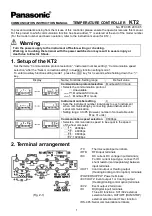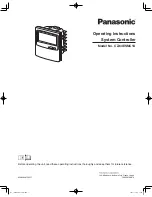
//
RF HB SW2.4-IND
st
eut
e T
echnol
ogies GmbH & Co. K
G
Brück
ens
tr
aße 91, 32584 Löhne, Germany
, www
.s
teut
e.c
om
3 / 16
Montage- und Anschlussanleitung / Funk-Handbediengerät
Mounting and wiring instructions / Wireless hand control
Instructions de montage et de câblage / Télécommande sans fil
Istruzioni di montaggio e collegamento / Dispositivo di comando manuale wireless
Instruções de montagem e instalação / Controle remoto sem fio
Инструкция по монтажу и подключению / Прибор ручного радио-управления
Replace the battery:
1. Terminal shutdown.
2. Open battery housing - Unbolt both battery housing screws.
3. Remove empty batteries and insert new ones. Ensure correct polari-
ty (see marking).
4. Close battery housing - Tighten both battery housing screws.
Maintenance and cleaning
.steute recommends routine maintenance as follows:
1. Remove all dirt particles: Clean enclosure on the outside only.
Clean device in accordance with IP protection class (IP54).
Clean with a soft cloth and water or a mild detergent. Do not
clean using compressed air.
2. Test the function.
Disposal
The device contains electronic components, cables and plastic compo-
nents. The owner is responsible for correct disposal of the device and
its attachments. Local and industry-specific environmental stipula-
tions must be observed when disposing of the foot switch, its attach-
ments and packaging. Battery disposal: Old batteries contain contami-
nants and heavy metals which are both unhealthy and harmful to the
environment. For this reason consumers are obliged to dispose of bat-
teries by taking them to a recognized collecting point provided by re-
tailers and local authorities.
N.B.
Regulatory information on the OEM device should contain the following
labelling: Approved in accordance with R&TTE directive transmitter
module marked by CE, manufactured by steute registered as OEM
product. FCC Regulatory Information The Federal Communication
Commission Radio Frequency Interference Statement includes the fol-
lowing paragraph. This equipment has been tested and found to com-
ply with the limits pursuant to Part 15 of the FCC Rules. These limits
are designed to provide reasonable protection against harmful inter-
ference in a residential installation. This equipment generates, uses
and radiates radio frequency energy and, if not installed and used in
accordance with the instructions, may cause harmful interference to
radio communication. However, there is no guarantee that interference
will not occur in a particular installation. If this equipment does cause
harmful interference to radio or television reception, which can be de-
termined by turning the equipment off and on, the user is encouraged
to try to correct the interference by one or more of the following meas-
ures: -Reorient or relocate the receiving antenna. - Increase the sepa-
ration between the equipment and receiver. -Connect the equipment
into an outlet on a circuit different from that to which the receiver is
connected. -Consult the dealer or an experienced radio / TV technician
for help. Radiofrequency radiation exposure information: This equip-
ment complies with FCC radiation exposure limits set forth for an un-
controlled environment. This equipment should be installed and oper-
ated with minimum distance of 20 cm between the radiator and your
body. This transmitter must not be co-located or operating in conjunc-
tion with any other antenna or transmitter. Non-authorized modifica-
tion could void authority to use this equipment. »This device complies
with Part 15 of the FCC Rules and with RSS-210 of Industry Canada.
English
peated disturbances (radio disconnection), radio network planning is
necessary.
Assignment of the place of use:
Place of use
According to
EU
2014/53/EU (RED)
USA
Canada
FCC
IC
Start-up
Pairing
CAUTION! To avoid accidental action at the end terminal, the terminal
should be shut down during the pairing process.
1. Set receiver to pairing mode (see receiver mounting and wiring
instructions).
2. If not yet done, please insert the batteries.
3. a) The device has never been paired before and will start up in
pairing mode.
b) If paired before, wait for the device to enter sleep mode (>2.5 s),
then press the buttons three/four (3/4) at the same time and hold
them for up to 3 s.
4. Transmitter and receiver are now in pairing mode and will exchange
data, see LED display!
5. After successful pairing the device is operational.
Assignment of receiver functions
The four buttons on the device trigger one receiver relay each. The
keypad labelling corresponds to the assigned receiver relay (S1 -> K1,
S2 -> K2, S3 -> K3, S4 -> K4). For receivers with validate (VAL), the re-
dundant button S1 will additionally trigger the validate relay K4. In this
case the button S4 remains without function.
LED display of the receiver
State
Description
green flash (0.1 s)
battery capacity > 10 %
red flash (0.1 s)
battery capacity < 10 %
red blink (1 s)
no wireless connection
green & red alternating (1 s)
pairing mode
Battery replacement
Notice
- During battery replacement the terminal must be switched off in
order to rule out any unintended triggering of functionality.
- Only use alkaline batteries.
- Never mix used and new batteries.
Battery type: 3 x IEC- LR03 (Type AAA – »Micro«)
- Every alkaline batteries of this type is fundamentally useable. How-
ever, to achieve the envisaged running time, the battery capacity
should exceed ≥1.2 Ah.


































